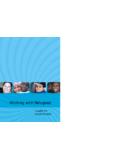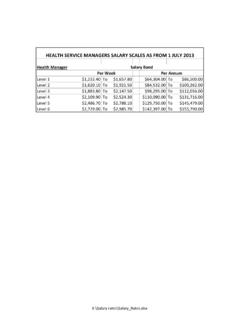Transcription of Social Workers A guide for Working with Refugees - STARTTS
1 A guide for Social WorkersWorking with RefugeesContents1. WHO IS A REFUGEE? have Refugees experiencedbefore arrival in Australia? s Refugee and Humanitarian countries do Refugees come from?8 CASE STUDY 1: MR T102. THE IMPACT OF THE REFUGEE consequences of the refugee experience14 consequences of the refugee experience16 Implications for settlement17 CASE STUDY 2: MS Y183. Working WITH SPECIFIC REFUGEE women24 and young refugees28 CASE STUDY 3: MRS C304. SKILLS FOR Social Workers Working WITH refugee Cross-cultural communication35 Working with interpreters36 issues of tortureand trauma38 trauma treatment with asylum seekers42 in the effective up with current traumatisation46 and burnout5.
2 Readings54 Glossary1 This resource was produced by the NSW Refugee Health Serviceand STARTTS (NSW Service for the Treatment and Rehabilitationof Torture and Trauma Survivors), under the guidance of a Steering Committee and with the support of Social Workers andmulticultural health staff from the Bankstown, Fairfield andLiverpool Health following documents served as key information sources:Bowles, R. (2001) Social work with refugee survivors of tortureand trauma . Reproduced by permission of Oxford University PressAustralia from Social Work Fields of Practiceby Margaret Alston andJennifer McKinnon Oxford University Press, Council of Australia (2003).
3 NSW Advocates Help , General Practice Unit (South Western Sydney AreaHealth Service), CHETRE (Centre for Health Equity Training,Research & Evaluation) and NSW Refugee Health Service (2000). Managing survivors of torture and trauma. Guidelines forGeneral Practitioners . NSW Refugee Health Service: 1-74079-055-3 Sydney Australia September 2004 Service for the Treatment and Rehabilitationof Torture and Trauma SurvivorsForewordIn recent years the situation of refugeeshas again become a major issue forAustralia. It is rare to see a day in whichsome aspect of Australia s response tothose who seek asylum here is not debatedin the various media.
4 In this context it istimely that Social Workers should seek toimprove their capacities to contribute tocare for all those who have sought work as a profession clearly hasmuch to offer in services for a skill base that integrates intra-personal and inter-personal helping withthe practicalities of assisting people tonegotiate their way around the socialwelfare system, Social Workers can respondto the complex needs of Refugees withinan understanding of the wider context offamily relationships and socialinstitutions. The values of Social work,acknowledging principles of both socialjustice and the dignity and worth of eachindividual person, likewise enable socialwork to focus on the importance ofensuring that responses to Refugees arewell considered and resource material presented hereprovides Social Workers with importantinformation about Refugees .
5 Refugees arediverse ethnically, including people of allages and socio-economic backgrounds,both women and men. At the same timethere are shared factors in the refugeeexperience that set people apart fromothers who may share their ethnicity orbackground. These materials carefullyportray the diversity of Refugees while atthe same time guiding Social Workers inthinking about what is unique in therefugee experience and ways in whichsocial Workers can respond are facts and figures, tips for goodpractice and the use of case studies toillustrate issues more is a comprehensive guide for busypractitioners that will prove invaluable associal Workers seek to develop and extendresponses to the particular needs ofrefugees in our Hugman PhDProfessor of Social WorkUniversity of New South WalesAugust What have Refugees experienced before arriving in Australia?
6 Who is a Refugee?Someone who has fled their country oforigin and is at risk of persecution becauseof race, religion, political opinion,nationality, or membership of a particularsocial group. Persecution usually meansexecution, torture, imprisonment withouttrial, mistreatment and/or other seriousdenial of rights. Refugee is an internationally acceptedlegal term to describe someone needingprotection from another country becausethey are being targeted by authorities orother groups involved in an organisedviolence campaign in their own cannot be applied to people seeking toescape random violations of their rights,escaping violence in a civil conflict,fleeing natural disasters, or escapingstarvation.
7 Who is an Asylum Seeker?Someone who has applied for protectionas a refugee and is awaiting determinationof their status. All Refugees have beenasylum seekers either in Australia or inanother country, but not all asylumseekers are found to be is a Humanitarian Entrant?In Australia, this means Refugees andother people at risk of serious humanrights violations. This guide will use refugee to describe allpeople from a refugee background,including humanitarian entrants andmigrants who have had refugee-likeexperiences before arriving in in the countryof originThe persecution that Refugees try toescape from includes: imprisonment without trial severe harassment by authorities torture witnessing killing or torture of close family members, friends and comrades aerial bombardments disappearance of close family members.
8 Experiences in exileSome people take extreme risks to reachsafety. Some will have left in secret or in atime of chaos, and had little opportunityto say goodbye to family and friends, oreven pack their belongings. Many familiesbecome separated in the process arriving in Australia, Refugees mayhave spent many years in refugee in camps is extremely difficult, withpoor medical care, overcrowding, foodshortages, few educational facilities, and alack of safety. Sexual assault is endemic inmany possible consequences of these experiences.
9 Psychological trauma due to persecution, war or civil conflict, and the circumstances leading to and surrounding it Social dislocation loss, including separation from family and friends insecurity, including real actual or threatened physical violence and rape overcrowding, poor hygiene and under-nutrition, particularly for those who have been imprisoned or in camps poor medical care, due to destruction of infrastructure and disruption to health services by fighting in the country of origin, and through limited access to health care whilst fleeing and whilst seeking asylum disrupted education of children lost or interrupted careers for Australia s Refugee and Humanitarian ProgramAustralia has a long history of helpingrefugees and other survivors of humanrights abuses.
10 Since World War II,approximately 600,000 Refugees havesettled here. Currently, some 12,000humanitarian entrants settle in Australiaeach year, about 40% of them in New South Wales. Many people whoarrive as migrants may have refugee-likebackgrounds they have experiencedwar or organised arrive in one of two ways. Mostare selected from overseas by the AustralianGovernment to settle in Australia as partof our commitment to protectingvulnerable people worldwide. A smallernumber have come to Australia to seekprotection as asylum are a number of different visas thatfit under Australia s Refugee andHumanitarian Program, but the mostimportant distinctions to remember are: Refugees and humanitarianentrants selected from overseaswith permanent visasMost Refugees settling here are selectedfrom overseas by the AustralianGovernment.



